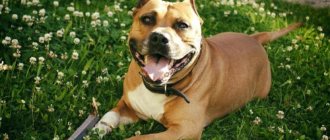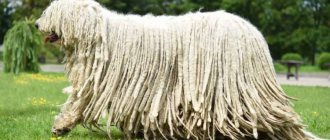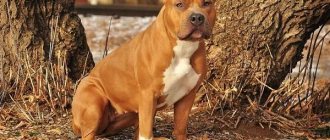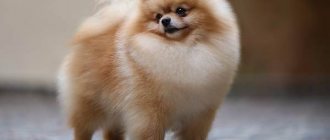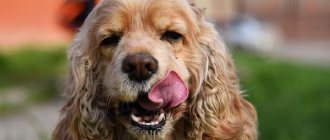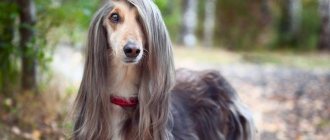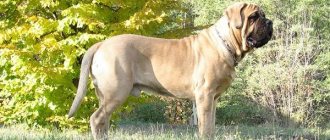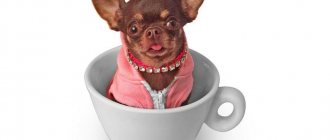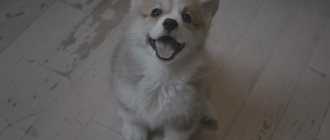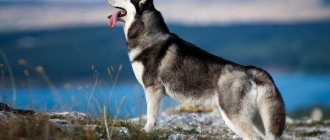American Bulldog (ambul)
Ambul is much stronger and healthier than its English counterpart. He is able to cope with a bull alone, and in a calm environment he turns into a sweet and good-natured hulk. With proper upbringing, the protective qualities of the breed are expressed in touching care for the owners and their children.
Photo: sobakevi4.ru
Shih Tzu
- Height: from 23 to 28 cm
- Weight: from 4 to 7.3 kg
- Life expectancy: 10 to 18 years
- Average cost: from 1000 to 1800 dollars
This incredibly popular little dog was developed around 1000 BC in ancient China, where they were kept as royal pets. The Shih Tzu was bred as a cross between the Lhasa Apso and the Pekingese.
Shih Tzu literally translates to "little lion" . Legend has it that Buddha had a small Shih Tzu, and one day while he was traveling, robbers ambushed him with the intention of robbing him and killing him. To protect its owner, the little dog turned into a huge lion and scared away the criminals!
Being cute is the goal of this adorable dog's life. Shih Tzus are known to be especially affectionate with children. As a small dog bred to spend most of its day in royal palaces, it makes a great pet if you live in an apartment or have a large backyard. Shih Tzus get along well with cats and other dogs, making them ideal furry pets.
American Pit Bull Terrier
The name of the breed comes from the word pit - pit for dog fighting. The Pitbull is a natural athlete with the soul of an eternal puppy and the temperament of a champion, lively and cheerful at home, but merciless in the ring. When keeping a dog’s unbridled energy in an apartment, it is important to channel it in the right direction.
Photo: hotwalls.ru
Care and maintenance
In terms of grooming, the Bull Terrier is not difficult, he is clean:
- Brush the coat with a rubber mitten 2-3 times a week, daily during the shedding period.
- Clean your ears once a week.
- Wash your eyes daily.
- After walking, wipe with a damp towel.
- Bath with shampoo as needed.
- Trim the claws.
Keeping exclusively at home, preferably in a family without children. Aviary and chain housing breaks the animal’s psyche and leads to its aggression. The bull is afraid of the cold; at temperatures below -10, walk in clothes. During the hot season, refrain from exposing your pet to the sun.
American Staffordshire Terrier (Amstaff)
A tireless athlete, a brilliant intellectual and a good-natured cheerful fellow - this is the impression a well-mannered Amstaff makes. Staffordshire Terriers are easy to train and try their best to please their owner. Sometimes it seems as if the dog reads minds! But the motivation should only be positive - violence and rudeness spoil the character of the animal.
Photo: aliexpress.ru
Dogo Argentino
The ancestors of the Dogo Argentino accompanied the Spanish conquistadors on military campaigns. The snow-white hidalgo has not lost his aristocratic dignity even today - the dog rarely gives a voice and attacks silently. Dogo Argentinos are unshakably confident and even stubborn, but at the same time they adore their owners and need attention, affection and encouragement.
Photo: pet-mir.ru
Small dog breeds: names and photos (catalog)
Dogue de Bordeaux (French Mastiff)
One of the oldest guard breeds in Europe comes from the Kingdom of Aquitaine. In the Middle Ages, these dogs guarded butcher shops and fought bulls for the amusement of the public. When cruel fun was banned, the affectionate and playful Bordeaux became companions and family friends, but did not lose their protective qualities. The dog relentlessly follows its owner and is always ready to defend him.
Photo: lapkins.ru
Chinese Shar Pei
- Height: from 45.7 to 50.8 cm
- Weight: from 20.4 to 27.5 kg
- Life expectancy: 8 to 12 years
- Average cost: from 1000 to 1500 dollars
The Chinese Shar Pei was also developed during the Han Dynasty, but has a more troubled past than the Chow Chow. The breed was on the verge of extinction in 1949 when the communist regime after the founding of the People's Republic of China opposed dog ownership. Fortunately, the Chinese Shar Pei survived and was officially recognized in 1992.
The Chinese Shar Pei performs best when it can make its own decisions, so it is important to prioritize obedience training with positive reinforcement to help your pet respond correctly to your cues.
Along with their blue-black tongue, these dogs are also famous for their wrinkled appearance. They should be bathed monthly and the folds between the wrinkles should be kept dry and clean. Ear cleaning is a priority and should be done weekly using a cleaning solution recommended by your veterinarian.
Bullypit (American Bully)
The youngest fighting breed, which made its name at the end of the last century. The character of a bodybuilder dog successfully combines the sports passion of a pit bull and the affection of a bull terrier. A stocky, squat dog with a big brave heart is endowed with heroic strength, but it is extremely difficult to provoke him into aggression. The dog's self-control deserves admiration - for the sake of its beloved owner, the bullypit will endure anything!
Photo: mnogo-krolikov.ru
Bullmastiff
In England in the 17th and 18th centuries, bullmastiffs tracked poachers on lords' lands. The breed’s excellent sense of smell and watchdog qualities are highly valued in the police and army, and at home it is simply a reliable friend and playmate. The fight for leadership is not in the nature of the bullmastiff, but he has his own opinion about everything in the world, which he stubbornly defends. You can convince a dog only with patience, not brute force!
Photo: mirzhivotnye.ru
Kinds
The main task of breeders is to breed genetically healthy individuals for subsequent reproduction. Attempts by dog handlers to create a related breed with a new color result in the birth of dogs with developmental defects. The French Bulldog breed is represented exclusively by brindle and fawn colors, recognized by the FCI.
Solid and spotted color options are allowed. The brindle color is considered more traditional; fawn was recognized in 1995. Shades of coat color in a wide range: from light to dark brown. The fawn base is combined with a black mask on the dog's face.
There is a variant of the black and brindle color allowed by the standard. The French bulldog is black only at first glance from a distance. In fact, fawn hairs are visible or visible spots appear in the sun.
Decorative bulldogs are initially small in size and come in two types: standard and mini. The first variety is the result of selection work, purebred individuals for exhibitions and procreation. The second is dwarf creatures for indoor pastime.
The mini French bulldog loves to sleep on a pillow; he is naturally lazy. A dog needs physical activity to stay fit and improve health. The pet will need to be involved in games so that the dog does not suffer from obesity.
Fans of dwarf varieties should be careful when buying a dog, since sick, underfed individuals are often sold under the guise of mini dogs. The mini bulldog is the result of selection based on the dwarfism gene, although the breed standard does not allow such deviations.
Bull Terrier
Small but brave - that’s what the bull terrier is all about! A small but well-built dog shows miracles of courage, endurance and perseverance, and its powerful grip allows it to defeat even an opponent who is superior in strength. In peaceful life, the Bull Terrier is an energetic, quick-witted and cheerful companion who strives to participate in all family affairs.
Photo: pixy.org
Is it worth getting a fighting dog?
A fighting dog is naturally endowed with traits that are difficult to handle without training. If you decide to get a pet, then consider the following factors:
- Each breed has its own positive and negative traits. You should definitely know them before purchasing.
- The future owner is distinguished by courage, determination, and the ability to make quick and correct decisions.
- A genetic predisposition to aggression can manifest itself at any time: during a walk, when you are exercising, if another dog approaches. Behavior must be constantly monitored.
- War dogs are distinguished by their endurance and mobility. This is supported by regular physical training and long walks.
- Some dogs are prone to obesity and rapid weight gain. This is regulated by proper nutrition.
If you decide to get a fighting dog, you take full responsibility for proper upbringing in an urban environment. Socialization is absolutely necessary, including special obedience classes with dog handlers.
Spanish Mastiff
Even among the huge Molossians, the Spanish Mastiff looks like a hero - males reach a weight of 120–130 kilograms. The dog is fully aware of its power and does not stoop to petty squabbles, but will not offend its owner. The Spanish Mastiff is strict and cold with strangers, but around the family it is cheerful and playful. And the impregnable giants adore children and forgive the little naughty ones absolutely everything!
Photo: zverushki.media
Medium dog breeds: names and photos (catalog)
Nutrition
Keeping a Gul Dong dog is not cheap. The powerful muscular frame of the Pakistani needs constant replenishment with protein. When purchasing a dog, you need to make a choice in favor of natural food or dry food, and not mix these food lines in the future.
Natural food
The Pakistani Bulldog eats about 3 kg of meat during the day. The basis of the diet is:
- Lean meat and fish;
- Giblets;
- Broths based on meat and fish, soups based on them;
- Porridge to provide the body with fiber;
- Fermented milk products: cottage cheese, kefir, yogurt;
- Fresh vegetables to maintain vitamin balance.
Dogs are prohibited:
- Fat meat;
- Bones;
- Bread products;
- Legumes, corn, onions, potatoes;
- Sweet, salty, sour, bitter, pickled, fried, smoked food.
Dry food
Dry food should satisfy the Pakistani Bulldog's body's need for proteins and vitamins. Gul dong needs a quality product. The daily amount of food should be selected based on the needs and age of the dog, as well as the composition of the food.
Regardless of the type of food, a Pakistani needs constant access to plenty of drinking water and periodic use of vitamin complexes.
Diet for an adult dog (from six months): 1-2 times a day. Malnutrition is most pronounced in the lower ribs. If the lower costal arches begin to bulge, the dog needs to increase the amount of food.
Ca de bou (Mallorcan Bulldog)
The ancient fighting dog breed came to Spain from the Balearic Islands. In the old days, ca de bos took part in bullfights along with bullfighters, and in our time they delight their owners with cheerful pranks and a light, sunny character. At the same time, the Mallorca Bulldog has not lost its protective qualities - the dog can easily pull down a bully and drive the uninvited guest out of the yard without showing excessive aggression.
Photo: zoowed.ru
Lhasa apso
- Height: from 25.4 to 28 cm
- Weight: from 5.5 to 8.5 kg
- Life expectancy: 12 to 15 years
- Average cost: from 1500 to 2500 dollars
This Chinese dog breed dates back thousands of years and was originally used to protect Buddhist monasteries in the Himalayas. The Lhasa Apso is considered one of the most sacred breeds in China and was only allowed to leave the country if it was gifted by the Dalai Lama as a symbol of good luck and prosperity. The first pair of Lhasa Apsos were sent to the United States as a gift to researcher S. Suydam Cutting in 1933, and soon the whole world fell in love with this long-haired dog.
Fun fact: In Tibetan folklore, the protector of China is the mythical Snow Lion, and the Lhasa Apso, the “bearded lion dog ,” is the earthly representative of the Snow Lion. "Lhasa" is the name of the holy city of Tibet; "apso" means "long-haired dog."
Despite their relatively small stature, these Chinese "lion dogs" live up to their nickname by always keeping a watchful eye on their family members. What could be even better? The Lhasa Apso can be your canine companion for 12-15 years.
Cane Corso
Restrained and calm in appearance, when you get to know each other closely, Cane Corso dogs amaze you with their tender affection for their owner. They are wary of strangers, but do not show unmotivated aggression. With proper training, the Cane Corso will make an excellent bodyguard. The dog is easy to train, calculates risks well and, in the event of a real threat, acts decisively and with lightning speed.
Photo: 100zaitsev.ru
Briefly about the main thing
- The Fighting Dog differs from other Wolfdogs in its ability to immediately enter into battle for itself or others, to protect its home, territory, family.
- Most breeds are characterized by stubbornness and disobedience. It is genetically embedded in them and is inherited.
- All breeds require attention and activity, constant training and long walks in the fresh air.
- Each representative has its own characteristics that need to be studied before deciding to purchase a puppy.
- You cannot buy from unknown breeders in order to avoid damage to the breed and excessive aggression when growing up.
- The owner is obliged to study the principles of canine training in the behavior of fighting dogs and bear full responsibility for the correct approach to the pet without cruelty, with patience and attention.
Neapolitan Mastiff
Due to its impressive dimensions and many folds on its face, the Neapolitan Mastiff seems like a creepy creature from hell. In ancient Rome, the ancestors of the formidable Neapolitans took part in gladiatorial battles and military campaigns. Thousands of years of selection have balanced the protective instinct and rage towards the enemy with strong nerves and the docile nature of the breed. In the family circle, these phlegmatic giants are kind, affectionate and generous.
Photo: kotsobaka.com
How to choose
Puppy or teenager, adult dog differ greatly from each other. Depends on many conditions:
- pedigree;
- purity of breed lines;
- maintenance, parenting.
No breeder will give away a puppy at an early age, without vaccinations. Before purchasing, you should familiarize yourself with the breed offers. Each of them has its own characteristics, which the puppy’s owner is sure to talk about.
You need to know what you eat and how to make your diet more balanced. Prepare in advance for the meeting with your planned pet. Study all the characteristic features, watch videos and photographs.
When buying a puppy or junior, pay attention to:
- on the condition of the coat, which should be shiny, healthy, free from parasites;
- behavior is characterized by activity, playfulness, loud barking at the sight of a stranger;
- a healthy puppy is cheerful, does not itch, does not rub, and has no streaks in his eyes.
An honest seller will put it in an exhibition stand, show the parents (father, mother), talk about successes, features of development, feeding, behavior.
Don't be afraid to ask questions. Try to avoid the temptation to buy cheaper, “cull”. In the future, such a wrong step will affect the development of fighting dogs.
We must remember that there will always be “fashion” for certain breeds. You should not take a dog just because it is prestigious now. The choice must be made with heart, soul and logic. Assess maintenance and care options. This helps to avoid mistakes.
Central Asian Shepherd Dog (Alabai)
Alabai is the national pride of Turkmenistan and one of the oldest breeds in the world. At dog fights, the strongest and most persistent fighters were selected, who would not be afraid of either a wolf or a bear. There are legends about the nobility of the breed: Turkmens claim that in the ring the Alabai does not finish off a defeated opponent. The dog will protect its owner to the last drop of blood, but will not tolerate rudeness and injustice.
Photo: moi-zhivotnye.ru
The most beautiful dog breeds: names and photos (catalog)
Classification of fighting dog breeds
When selecting Volchis for a group, they are still guided by several factors:
- Strong paws, large head and developed jaws.
- The body structure is powerful, allowing it to withstand physical stress.
- Most fighting dogs have close-fitting fur. A specific feature is stretching, which minimizes injuries.
- Basically all breeds are smooth-haired. The exception is dogs, which were originally intended for hunting. Their hair is fluffy, with a rich undercoat.
The classification involves division into groups based on origin. These include:
- bulldogs;
- mastiffs;
- terriers;
- shepherds
There are also representatives who do not belong to any of the groups due to the characteristics of their origin.
Due to different characteristics, they are divided into groups by size (small, medium, large) when the height of an adult dog is determined. Another classification is wool (short, medium, long). Some have several subspecies of wool at once, which allows them to withstand weather loads of varying intensity.
Presa Canario (Dogo Canario)
The brutal, handsome Dogo Canario is the embodiment of strength and dignity. A sensitive guard will not make a fuss over a trifle and will not attack the first person he meets - the breed is famous for its endurance and prudence. At the same time, wariness does not prevent the Presa Canario from enjoying life: dogs love to play with their owners and are not averse to playing pranks with children.
Photo: nonparell.ru
Rottweiler
The reputation of Rottweilers as evil, aggressive animals was created by stupid owners. In fact, the natural ferocity in the character of these dogs is easily suppressed by education, so reliably that later, if you want to develop a fighting temperament, it has to be “awakened” on purpose. But the owner who has achieved success in this matter can fully expect that sooner or later the dog will attack him.
Bite force – 150 kg per square meter. cm, the jaws act like scissors - the upper one overlaps the lower one, which makes it easy to tear out pieces of flesh. In some countries, the dog is officially listed as not recommended for pets, since collisions with representatives of this breed cause the greatest number of deaths.
The Rottweiler has a reduced pain threshold, is fearless, and is quick to attack. But the dog rarely attacks first; it is too phlegmatic for this. The main characteristics of the Rottweiler are intelligence, stubbornness and leadership qualities. Any actions of the dog in battle are thought out; he does not give up or retreat. And his strength and physical parameters (height - up to 70 cm, weight - up to 50 kg) allow him to emerge victorious even from fights with the most dangerous opponents.
Tosa Inu (Tosa Token, Japanese Mastiff)
The only fighting dog breed from Japan fights using the sumo technique - it does not tear or crush the enemy, but delicately lays him on his shoulder blades. The animal behaves with true Japanese composure - even in the heat of a fight it will not make a sound. With his owner, the four-legged samurai is polite, helpful and reserved, but avoids violent outpourings of feelings.
Photo: krasivosti.pro
Other fighting breeds
Among other dogs, there are those whose fighting character automatically classifies them into the group, but does not distinguish them into a specific subspecies.
Akita Inu
The dog comes from Japan with a high head, long legs and a cute face. Looks like a fox or smiles all the time. An excellent breed for protection, although it looks like a toy. Obedience training should be done by someone who is able to overcome an Akita. They need constant training and classes. If they are bored, they can start a fight and enter into battle.
The increased level of aggressiveness is explained by the dog’s original purpose for hunting and protecting livestock, accompanying people on long journeys. He is friendly with the owner and does not interact well with other dogs.
American Akita
A variety of Japanese Akita Inu with selection in the USA. They are easier to train and have less aggression. Too pleasant an appearance “lulls one’s vigilance.” Compared to their relatives from Japan, they are friendly and are not able to attack first. They obey the owner, protect the family and the territory of residence. They love long training sessions and are easy to train.
Rottweiler
The breed is exclusively for those who can cope with a bad temperament. A wayward dog is capable of lunging, attacking, and chasing. A strong jaw grip can instantly disable an enemy. A powerful body, strong paws and a high level of endurance make the dog a real guard.
The dog is included in the list of dangerous, prohibited breeds in many countries around the world. Requires an experienced canine approach. May show a sudden attack of discontent and break off the leash. It is advisable to carry out walks using a strict collar and a short leash.
Fila Brasileiro
In a number of countries, Fila are outlawed or equated to edged weapons, but the aggressiveness of the breed is greatly exaggerated and is most often associated with improper upbringing and insufficient socialization. In experienced and responsible hands, Fila is a faithful guardian of the hearth and a favorite of the children.
Photo: klkfavorit.ru
Did you like the post? Subscribe to our channel in Yandex.Zen, it really helps us in our development!
